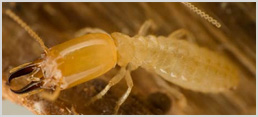Swarming Termites are very typical and completely a compulsory activity, and is put into motion for the sole purpose of reproduction and survival of the species. Termites swarm only after a colony has been established for three to five years, and the average Termite swarm lasts for only a few hours. The most common winged Termite activity that you will see is that of the Subterranean Termite, as the colony grows to one million plus insects. Those chosen by the queen to become reproductive males and females will be prodded out during peak mating season, usually between February and June in the southern climates, in hopes of pairing with a strong member of the opposite sex and starting a new colony.
 The Flight Pattern during termite swarm is very clumsy and exhausting for them, as they haven’t much practice at flying and their wings are not very strong. This may explain why the secondary wings on the Termite are the same size as the primary wings are, making it easier to catch more wind and stay afloat. The winged termite, while at rest, looks like a head with skinny wings attached to it. You can decipher a termite swarm from an ant swarm in this way, or by taking a close look at the antennae of the insect in question. The termite has straight feelers at the front of his head, whereas the antennae of the ant are always bent in one direction or another. Perhaps the most convincing character difference between Ants and Termites is that ants have three distinct body parts, while Termites have only two.
The Flight Pattern during termite swarm is very clumsy and exhausting for them, as they haven’t much practice at flying and their wings are not very strong. This may explain why the secondary wings on the Termite are the same size as the primary wings are, making it easier to catch more wind and stay afloat. The winged termite, while at rest, looks like a head with skinny wings attached to it. You can decipher a termite swarm from an ant swarm in this way, or by taking a close look at the antennae of the insect in question. The termite has straight feelers at the front of his head, whereas the antennae of the ant are always bent in one direction or another. Perhaps the most convincing character difference between Ants and Termites is that ants have three distinct body parts, while Termites have only two.
Termite swarms are usually a very quick and rarely seen event. These insects have a three hour window, or so, of opportunity to fly, mate, and burrow before their reserve energy is spent. This spells an exhausting and highly perilous day for both sexes, and very few of them are able to see it through to the fruition of a new colony. If there are any concerns that are involved with Swarming Termites, this would be the one. These tired and opportunistic Termites will basically swarm around the types of materials which they would need in order to develop a new colony, and once the mating ritual is through, a pair of them will begin to burrow in the closest area possible. Some simply drop to the ground and begin to dig in, only to die within moments. There will most likely be a lot of evidence left behind once the termite swarm pattern has dissipated, such as shed wings and demised insects.

Termite prevention is very much the same as if you were to guard against ants or roaches.
The basic rules apply to all of the above, and knowing all about them could save you a great deal of time, worry, and money.
For starters, you should rethink using any deteriorating wood or lumber either on your home or in the landscaping. It can be very quaint to set old railroad ties and slat board fencing around the perimeter of your home, but this is basically a welcome mat to termites. Don’t forget that they nest beneath their target structures, and then branch out from there to seek their ill gotten spoils. Don’t give them any reason to feel welcome in your yard at all.
Another popular adornment which undermined termite prevention is mulch. Any untreated or completely dead wood can, and will, attract them in droves. Many of your mulch and shaving packages will read that they are not attractants for insects, but this only lasts for one season if you are lucky. Leaving these types of materials to decompose will create the perfect environment for termite infestations. Firewood should be stored away from your home as well, but if you do keep it in the house during winter it should be held at an elevation of at least 5 inches from the floor. Termite prevention starts at the ground up, and you will definitely benefit from keeping it all as simple and clean as possible.
Trimming back your tree branches and bushes so that they have no immediately proximity to your exterior walls or roof will improve your chances of deterring termites as well. Cracks in the foundation, basement, and exterior walls of your home can be very inviting to the worker termite while he snitches around trying to get inside. Seal all of these crevasses well, checking during both spring and fall for new ones. Good ventilation through your attic and crawlspace areas will keep the humidity down, which is another key to effective termite prevention.


- Termites
- Pavement Ants
- Carpenter Ants
- Bed Bugs
- Fleas
- Roaches
- Spiders
- Ticks
- Mosquitos
- Mice
- Rats
- Wood Destroying Pests & Fungi
![]()
- Anne Arundel County
- Howard County
- Prince George's County
- Queen Anne's County






